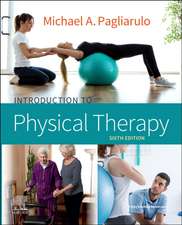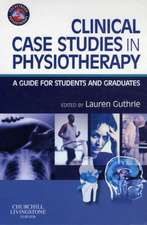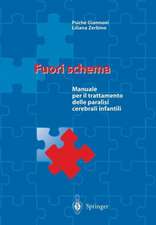Cerebral Palsy: A Practical Guide for Rehabilitation Professionals
Editat de Psiche Giannoni, Liliana Zerbinoen Limba Engleză Hardback – 28 feb 2022
The book is a valuable resource for physiotherapists, occupational therapists, speech therapists and other caregivers.
| Toate formatele și edițiile | Preț | Express |
|---|---|---|
| Paperback (1) | 539.06 lei 6-8 săpt. | |
| Springer International Publishing – mar 2023 | 539.06 lei 6-8 săpt. | |
| Hardback (1) | 739.13 lei 3-5 săpt. | |
| Springer International Publishing – 28 feb 2022 | 739.13 lei 3-5 săpt. |
Preț: 739.13 lei
Preț vechi: 778.03 lei
-5% Nou
Puncte Express: 1109
Preț estimativ în valută:
141.47€ • 147.13$ • 118.55£
141.47€ • 147.13$ • 118.55£
Carte disponibilă
Livrare economică 20 februarie-06 martie
Preluare comenzi: 021 569.72.76
Specificații
ISBN-13: 9783030856182
ISBN-10: 3030856186
Pagini: 511
Ilustrații: XVI, 511 p. 295 illus., 7 illus. in color.
Dimensiuni: 155 x 235 mm
Greutate: 1 kg
Ediția:1st ed. 2022
Editura: Springer International Publishing
Colecția Springer
Locul publicării:Cham, Switzerland
ISBN-10: 3030856186
Pagini: 511
Ilustrații: XVI, 511 p. 295 illus., 7 illus. in color.
Dimensiuni: 155 x 235 mm
Greutate: 1 kg
Ediția:1st ed. 2022
Editura: Springer International Publishing
Colecția Springer
Locul publicării:Cham, Switzerland
Cuprins
Chapter 1) Child Evaluation Guide and Clinical Reasoning.- Chapter 2) The Child with Bilateral Spastic Cerebral Palsy.- Chapter 3) The Child with Unilateral Spastic Cerebral Palsy.- Chapter 4) The Child with Dyskinesia.- Chapter 5) Ataxia in Cerebral Palsy.- Chapter 6) Sensory-Motor and Perceptual Problems in Cerebral Palsy.- Chapter 7) Therapeutic Approaches for the Soft Tissues.- Chapter 8) Guidelines for Upper Limb Rehabilitation.- Chapter 9) Upper Limbs Functional Problems in Different Forms of Cerebral Palsy.- Chapter 10) Feeding and Dysphagia in Children with Cerebral Palsy.- Chapter 11) The Child with Cerebral Palsy and Visual Impairment.- Chapter 12) Augmentative and Alternative Communication in Severe Motor Impairment.- Chapter 13) Rehabilitation Technologies for Sensory-Motor-Cognitive Impairments.
Notă biografică
Psiche Giannoni is a physiotherapist for the treatment of children and adult persons with neurological motor impairments. After two decades of clinical practice in the Italian national health service she founded and directed the ART Education and Rehabilitation Centre in Genoa. This first-hand experience on the strong link between education and treatment, as well as the participation in the activities of EBTA as Senior Bobath Instructor and Country Representative, allowed her to mature the conviction of the necessity to overcome the narrow borders of the many rehabilitation schools and explore the links with bioengineering approaches to assessment and quantitative analysis of treatment outcomes also using new technologies. For this reason she is now affiliated with the Department of Informatics, Bioengineering, Robotics and Systems Engineering, University of Genoa, in order to guide and support their research activity in rehabilitation engineering with the multiple and multifaceted aspects of designing the optimal treatment for the specific impaired person.
Liliana Zerbino is a physiotherapist who has worked, throughout her long career in the public and private sector, for the evaluation and treatment of children with neurological motor impairments, with a specific focus on the interaction with the family, aimed at the joint formulation and sharing of the step-by-step goals of the rehabilitation project. She is EBTA Senior Bobath Instructor and currently is teaching and training rehabilitators in various Italian public and private rehabilitation facilities. In 1993 she was project coordinator of the ONG GVC Onlus, promoted by the Italian Ministry of Foreign Affairs in the framework of Italy-Palestine Cooperation, for training health personnel and establishing new clinics/rehabilitation centres in the Jenin area of Palestine. For many years, in cooperation with Psiche Giannoni, she has organized and taught courses, bothat the basic and advanced level, at the ART Centre of Genoa and at present is a lecturer in Pediatric Physiotherapy at the Master course of the Florence University. She is co-author with Psiche Giannoni of the book Fuori Schema published by Springer.
Liliana Zerbino is a physiotherapist who has worked, throughout her long career in the public and private sector, for the evaluation and treatment of children with neurological motor impairments, with a specific focus on the interaction with the family, aimed at the joint formulation and sharing of the step-by-step goals of the rehabilitation project. She is EBTA Senior Bobath Instructor and currently is teaching and training rehabilitators in various Italian public and private rehabilitation facilities. In 1993 she was project coordinator of the ONG GVC Onlus, promoted by the Italian Ministry of Foreign Affairs in the framework of Italy-Palestine Cooperation, for training health personnel and establishing new clinics/rehabilitation centres in the Jenin area of Palestine. For many years, in cooperation with Psiche Giannoni, she has organized and taught courses, bothat the basic and advanced level, at the ART Centre of Genoa and at present is a lecturer in Pediatric Physiotherapy at the Master course of the Florence University. She is co-author with Psiche Giannoni of the book Fuori Schema published by Springer.
Textul de pe ultima copertă
This book helps rehabilitators and caregivers understand the multifaceted needs of children with cerebral palsy or other neuromotor impairments in order to plan and implement an effective treatment regimen. Drawing on the authors’ extensive experience spanning several decades, it addresses the sensitive challenge of rehabilitation, which cannot and must not be confined by the rigid schemes of established schools. In particular, the book provides numerous practical suggestions, intended to guide the reader through correct clinical reasoning, setting goals and subsequent treatment. Furthermore, it includes chapters on evaluating and treating the upper limbs, feeding and communication problems, as well as on the care of soft tissues and the management of the visual difficulties in these children.
The book is a valuable resource for physiotherapists, occupational therapists, speech therapists and other caregivers.
Caracteristici
Shows how to manage the functional problems linked with cerebral palsy Advises practitioners/caregivers on how to handle children with cerebral palsy Includes “what to do” cards intended to guide the rehabilitator towards correct clinical reasoning



















